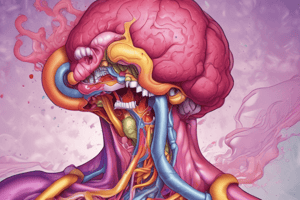Podcast
Questions and Answers
A patient with a duodenal ulcer reports experiencing pain. When is this pain most likely to occur in relation to meals?
A patient with a duodenal ulcer reports experiencing pain. When is this pain most likely to occur in relation to meals?
- 2-5 hours after eating. (correct)
- Immediately after eating.
- Only upon waking up in the morning.
- 1-2 hours after eating.
A patient is diagnosed with a bleeding peptic ulcer. Which of the following nursing interventions is the priority?
A patient is diagnosed with a bleeding peptic ulcer. Which of the following nursing interventions is the priority?
- Initiating NPO status. (correct)
- Providing education on avoiding acidic foods.
- Administering oral sucralfate.
- Encouraging increased fluid intake.
A patient with a history of peptic ulcer disease presents with sudden, severe abdominal pain, rigidity, and guarding. Which complication should the nurse suspect?
A patient with a history of peptic ulcer disease presents with sudden, severe abdominal pain, rigidity, and guarding. Which complication should the nurse suspect?
- Exacerbation of the ulcer pain.
- Perforation with peritonitis. (correct)
- Gastrointestinal bleeding.
- Hypovolemic shock.
Which of the following medications requires specific timing in relation to meals to maximize its effectiveness in treating peptic ulcer disease?
Which of the following medications requires specific timing in relation to meals to maximize its effectiveness in treating peptic ulcer disease?
A patient with a peptic ulcer is prescribed a proton pump inhibitor (PPI). What is the primary goal of PPI therapy in this context?
A patient with a peptic ulcer is prescribed a proton pump inhibitor (PPI). What is the primary goal of PPI therapy in this context?
Which diagnostic procedure allows for direct visualization of an ulcer and the collection of biopsies to test for H. pylori?
Which diagnostic procedure allows for direct visualization of an ulcer and the collection of biopsies to test for H. pylori?
A patient with a known peptic ulcer reports experiencing black, tarry stools. What condition does this manifestation most likely indicate?
A patient with a known peptic ulcer reports experiencing black, tarry stools. What condition does this manifestation most likely indicate?
Which lifestyle modification is most important for a patient with peptic ulcer disease to prevent recurrence?
Which lifestyle modification is most important for a patient with peptic ulcer disease to prevent recurrence?
Flashcards
Peptic Ulcer Disease (PUD)
Peptic Ulcer Disease (PUD)
Breakdown in the stomach's protective lining, leading to erosion and ulceration by digestive enzymes.
PUD Risk Factors
PUD Risk Factors
H. pylori infection, NSAIDs, corticosteroids, alcohol, caffeine, stress, trauma, critical illness.
Gastric Ulcer Pain Timing
Gastric Ulcer Pain Timing
Pain 1-2 hours after eating in the left upper quadrant or mid-epigastric region.
Duodenal Ulcer Pain Timing
Duodenal Ulcer Pain Timing
Signup and view all the flashcards
Melena
Melena
Signup and view all the flashcards
Hematemesis
Hematemesis
Signup and view all the flashcards
Peritonitis
Peritonitis
Signup and view all the flashcards
PUD Patient Teaching
PUD Patient Teaching
Signup and view all the flashcards
Study Notes
- Peptic Ulcer Disease occurs when there is breakdown in the protective lining of the stomach mucosa caused by mucosal injury
- It results in the erosion and ulceration of protective mucosa, leading to the breakdown of underlying tissue by digestive enzymes
Risk Factors
- Presence of H. Pylori
- Certain medications like NSAIDs and Corticosteroids
- Alcohol use
- Caffeine intake
- Stress
- Trauma or critical illness can lead to stress ulcers
Clinical Features
- Gastric Ulcer causes pain in the left quadrant to mid-epigastric region
- The pain of a gastric ulcer gets worse 1-2 hours after a meal when food contacts the stomach lining and stimulates acid release
- Duodenal Ulcer causes pain two to five hours after a meal
- The pain of duodenal ulcers is experienced when food finally passes onto the duodenum
- Posterior ulcers manifest as back pain
- Antacids can reduce the severity of the pain
Complications
- GI Bleeding may present as:
- Melaena
- Hematemesis
- Perforation:
- Peritonitis, which includes diffused abdominal pain, rigidity, and guarding
Diagnostic Tools
- EGD (upper endoscopy) is performed to check the presence of an ulcer
- Upper endoscopy is used to cauterize the ulcer or take sample of tissue for biopsy, and check for the presence of H. Pylori
Nursing Interventions
- For Non-bleeding ulcers, administer antibiotic for H.pylori
- Administer Proton Pump Inhibitors to reduce the stomach acid
- Administer Sucralfate for GI mucosa protection
- Administer PO medication, which has to bind to stomach acid that is present in order to become effective by forming a protective lining within the stomach, either 2 hrs. after a meal or 1 hr. before meal
- For Bleeding Ulcers:
- NPO (nothing by mouth)
- Perform an Endoscopy as it is a common test used to find bleeding in the gastrointestinal (GI) tract (a doctor uses a camera to view the inside of the GI tract and look for signs of bleeding)
- Monitor hemoglobin and hematocrit, and transfuse packed RBC to ensure adequate perfusion to peripheral tissue
- Monitor for hypovolemic shock, watching out for sudden drops in blood pressure and tachycardia
Patient Teaching
- Focus on removing triggers that can lead to mucosal injury, such as:
- Avoiding acidic food
- Avoiding NSAIDs and caffeine
- Monitor for signs of bleeding such as:
- Hematemesis
- Melena
- Dizziness or lightheadedness
- Drop in BP
- Monitor for signs of perforation such as:
- Peritonitis
Studying That Suits You
Use AI to generate personalized quizzes and flashcards to suit your learning preferences.




